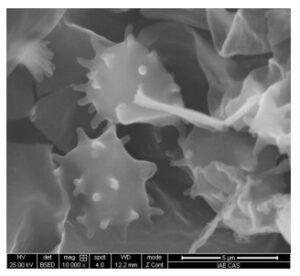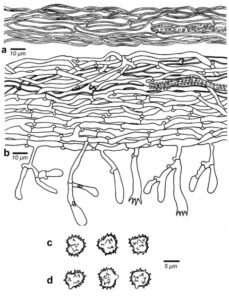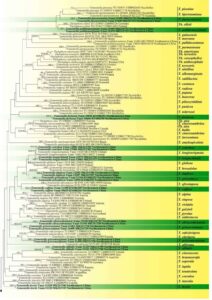Tomentella incrustata H.S. Yuan, X. Lu & Y.C. Dai, sp. nov.
Index Fungorum number: IF 555749; MycoBank number: MB 555749; Facesofungi number: FoF 05630; Figs. 1, 2, 3
Etymology – Refers to the encrusted generative hyphae.
Holotype – IFP 019299.
Basidiocarps annual, resupinate, separable from the substrate, pelliculose, without odour or taste when fresh, 1–1.5 mm thick, continuous. Hymenophoral surface smooth, pale brown to brown (6D8–6E8) and concolorous with subiculum when dry. Sterile margin often determinate, byssoid, concolorous with hymenophore. Rhizomorphs present in subiculum and margins, 6.5–25 μm diam; rhizomorphic surface more or less smooth; hyphae in rhizomorphs dimitic, highly differentiated, of type G; central hyphae clamped, thick-walled, rarely branched, 3–4 μm diam, with external encrustation, pale yellow in KOH, cyanophilous, inamyloid; skeletal hyphae at outer part of rhizomorphs thick-walled, unbranched, 1–1.5 μm diam, pale yellow in KOH, cyanophilous, inamyloid. Subicular hyphae monomitic; generative hyphae clamped and rarely simple septate, thin- to slightly thick-walled, frequently branched; dominant, mostly 2 μm diam and occasionally inflated to 4 μm diam, with external encrustation, pale brown in KOH, cyanophilous, inamyloid. Subhymenial hyphae clamped and rarely simple septate, thin-walled, frequently branched, 3–6 μm diam; hyphal cells short and not inflated, pale brown in KOH, acyanophilous, inamyloid. Cystidia absent. Basidia 10–30 μm long and 3–6 μm diam at apex, 3–5 μm at base, with a clamp connection at base, clavate, not stalked, sinuous, rarely with transverse septa, pale brown in KOH and in distilled water, 4-sterigmate; sterigmata 6–7 μm and 1.5–2 μm diam at base. Basidiospores slightly thick-walled, (5–)5.5–7(–7.5)×(4–)5–6.5(–7) μm, L=6.55 μm, W=5.83 μm, Q =1.08–1.15 (n=60/2), subglobose to bi-, or tri-lobed in frontal and lateral views, echinulate, pale brown in KOH and distilled water, cyanophilous, inamyloid; echinuli usually isolated, sometimes grouped in 2 or more, up to 1 μm long.
Material examined – CHINA, Liaoning Province, Anshan, Qianshan Park, on fallen angiosperm branch, 1 August 2017, Yuan 12189 (IFP 019299, holotype); Qingyuan County, Experimental Station of Forest Ecology, on fallen angiosperm branch, 3 August 2016, Yuan 11158 (IFP 019300).
GenBank numbers – ITS: MK211723, MK211722; LSU: MK446387, MK446386.
Notes – Tomentella umbrinospora and T. incrustata formed a clade in the phylogeny (Fig. 4), and they share similar morphological and anatomical characteristics: continuous basidiocarps separable from the substrate, a byssoid sterile margin, clavate basidia, a dimitic structure of the rhizomorphs and the absence of cystidia. However, T. umbrinospora differs from T. incrustata by having dark brick, umber or fulvous and arachnoid basidiocarps, thin-walled subicular hyphae and subglobose to bi-lobed basidiospores (Kõljalg 1996; Peintner and Dämmrich 2012). T. fuscogranulosa is similar to T. incrustata by the brown, pelliculose and continuous basidiocarps, the byssoid sterile margin, clavate basidia, the presence of rhizomorphs and subglobose to bi-, or tri-lobed basidiospores. However, T. fuscogranulosa can be distinguished by the occasionally collapsed subicular hyphae and the more or less uniform subhymenial hyphal cells.

Figure 1 – A basidiocarp of Tomentella incrustata (IFP 019299, holotype)

Figure 2 – SEM of basidiospores of Tomentella incrustata (IFP 019299, holotype)

Figure 3 – Microscopic structures of Tomentella incrustata (IFP 019299, holotype). a Hyphae from a rhizomorph. b Section through a basidiocarp. c Basidiospores in frontal view. d Basidiospores in lateral view

Figure 4 – Phylogenetic position of Tomentella species inferred from the ITS sequences. Bootstrap support values for ML≥50% and Bayesian posterior probabilities≥0.95 are given near nodes respectively. The tree is rooted with Odontia fibrosa (TU115714). The new species are in bold
